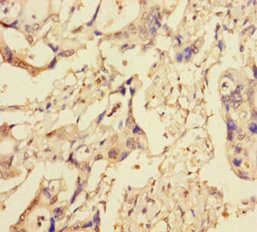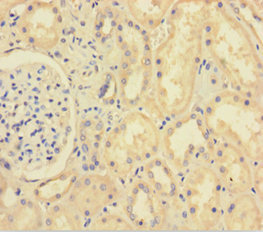
Immunohistochemistry of paraffin-embedded human pancreatic cancer using CSB-PA026193LA01HU at dilution of 1:100
XIAP Antibody
CSB-PA026193LA01HU
ApplicationsELISA, ImmunoHistoChemistry
Product group Antibodies
ReactivityHuman
TargetXIAP
Overview
- SupplierCusabio
- Product NameXIAP Antibody
- Delivery Days Customer20
- ApplicationsELISA, ImmunoHistoChemistry
- CertificationResearch Use Only
- ClonalityPolyclonal
- ConjugateUnconjugated
- Gene ID331
- Target nameXIAP
- Target descriptionX-linked inhibitor of apoptosis
- Target synonymsAPI3; baculoviral IAP repeat-containing protein 4; BIRC4; E3 ubiquitin-protein ligase XIAP; hIAP3; hIAP-3; IAP-3; IAP-like protein 1; ILP1; inhibitor of apoptosis protein 3; MIHA; RING-type E3 ubiquitin transferase XIAP; X-linked IAP; X-linked inhibitor of apoptosis, E3 ubiquitin protein ligase; XLP2
- HostRabbit
- IsotypeIgG
- Protein IDP98170
- Protein NameE3 ubiquitin-protein ligase XIAP
- Scientific DescriptionMulti-functional protein which regulates not only caspases and apoptosis, but also modulates inflammatory signaling and immunity, copper homeostasis, mitogenic kinase signaling, cell proliferation, as well as cell invasion and metastasis. Acts as a direct caspase inhibitor. Directly bind to the active site pocket of CASP3 and CASP7 and obstructs substrate entry. Inactivates CASP9 by keeping it in a monomeric, inactive state. Acts as an E3 ubiquitin-protein ligase regulating NF-kappa-B signaling and the target proteins for its E3 ubiquitin-protein ligase activity include: RIPK1, CASP3, CASP7, CASP8, CASP9, MAP3K2/MEKK2, DIABLO/SMAC, AIFM1, CCS and BIRC5/survivin. Ubiquitinion of CCS leads to enhancement of its chaperone activity toward its physiologic target, SOD1, rather than proteasomal degradation. Ubiquitinion of MAP3K2/MEKK2 and AIFM1 does not lead to proteasomal degradation. Plays a role in copper homeostasis by ubiquitinationg COMMD1 and promoting its proteasomal degradation. Can also function as E3 ubiquitin-protein ligase of the NEDD8 conjugation pathway, targeting effector caspases for neddylation and inactivation. Regulates the BMP signaling pathway and the SMAD and MAP3K7/TAK1 dependent pathways leading to NF-kappa-B and JNK activation. Acts as an important regulator of innate immune signaling via regulation of Nodlike receptors (NLRs). Protects cells from spontaneous formation of the ripoptosome, a large multi-protein complex that has the capability to kill cancer cells in a caspase-dependent and caspase-independent manner. Suppresses ripoptosome formation by ubiquitinating RIPK1 and CASP8. Acts as a positive regulator of Wnt signaling and ubiquitinates TLE1, TLE2, TLE3, TLE4 and AES. Ubiquitination of TLE3 results in inhibition of its interaction with TCF7L2/TCF4 thereby allowing efficient recruitment and binding of the transcriptional coactivator beta-catenin to TCF7L2/TCF4 that is required to initiate a Wnt-specific transcriptional program.
- ReactivityHuman
- Storage Instruction-20°C or -80°C
- UNSPSC12352203

